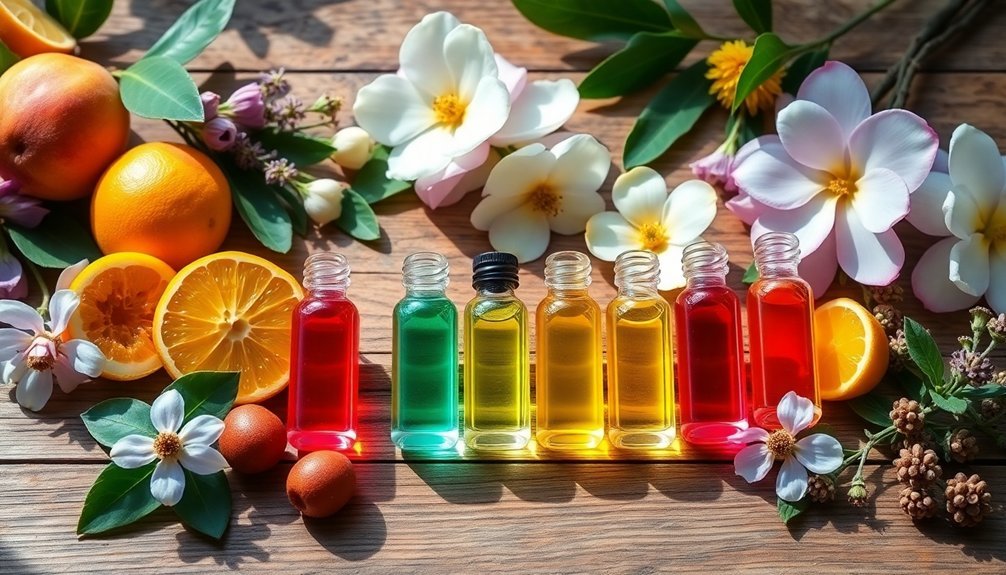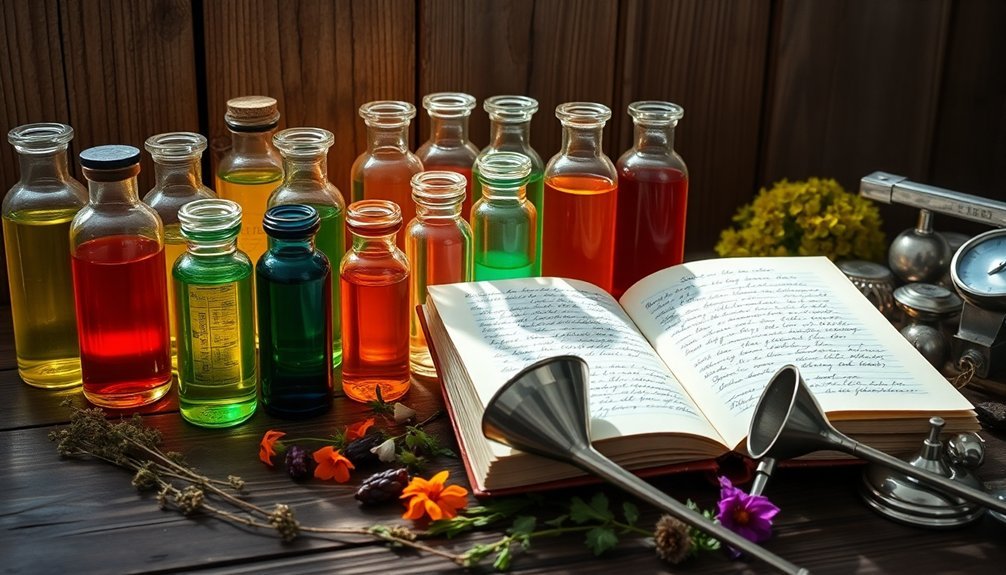When crafting homemade perfumes, you'll want to start with sweet top notes that create an inviting first impression. Citrus oils like bergamot and orange work beautifully, while light florals add complexity to your blend. Begin with 20-40% top notes in your formula, using roughly 9 drops for every 30 drops total. Store your creations in dark glass bottles at 60-70°F for best results. This essential foundation opens the door to countless aromatic possibilities.
Understanding Sweet Top Notes in Perfumery

Fragrance experts consider top notes the opening act of any perfume composition. When you apply your perfume, these initial scents will last about 5-15 minutes, creating that essential first impression that either draws you in or pushes you away.
These notes blend into the fragrance pyramid structure, creating a carefully orchestrated transition through the scent layers.
Sweet top notes, typically derived from light florals like rose and lavender, alongside gentle fruit essences, play an important role in your perfume's story. They're designed to evoke specific emotional responses while ensuring a smooth shift to the middle notes.
You'll notice these molecules evaporate quickly due to their high volatility, but that's exactly what makes them special.
The impact of sweet top notes goes beyond just scent – they're powerful triggers for memory and emotion, helping you create that perfect signature fragrance that resonates with your personal style.
Popular Sweet Top Note Essential Oils
When creating your own perfume, you'll find sweet citrus oils like bergamot, grapefruit, and orange serve as excellent top notes that immediately capture attention.
These fresh, fruity essences can stand alone or blend beautifully with floral elements like ylang ylang and geranium for added complexity. Proper dilution is essential before applying any essential oil blends to the skin.
Your homemade fragrance will benefit from the versatility of these oils, as they pair wonderfully with both light florals and deeper base notes while providing an uplifting initial impression.
Sweet Citrus Favorites
Among the most beloved ingredients in natural perfumery, sweet citrus essential oils create vibrant top notes that instantly captivate the senses.
You'll find lemon oil offering a fresh, rejuvenating scent that evaporates quickly while stimulating your olfactory receptors. Sweet orange oil stands out as a versatile and budget-friendly option, blending beautifully with florals, spices, and mints. Our commitment to using 100% authentic ingredients ensures each citrus oil delivers its full aromatic potential.
For complexity in your blends, try grapefruit oil, which balances sweetness with strong undertones and pairs well with rose, bergamot, and earthy scents.
If you're seeking the gentlest citrus option, mandarin oil delivers the sweetest, most calming profile, making it perfect for evening use.
Remember to take into account phototoxicity when working with citrus oils – proper dilution is essential to avoid skin sensitivity, especially with lime and bergamot varieties.
Floral-Sweet Essential Combinations
Sweet floral notes serve as the cornerstone of natural perfumery, with essential oils like lavender, rose, and jasmine leading the way in creating enchanting top notes.
These versatile oils don't just smell amazing – they'll also provide therapeutic benefits while forming the foundation of your signature scent.
- Start with lavender (Lavandula angustifolia) for its rich, herbaceous aroma that offers both stress relief and antimicrobial properties.
- Add rose (*Rosa damascena*) to encourage uplifting emotions and improve skin health.
- Include jasmine (*Jasminum officinale*) for its heady, sweet profile that's earned its reputation as the King of Oils.
- Balance your blend with complementary florals like orange blossom, tuberose, or clary sage.
When combining these oils, remember to start with small quantities and maintain detailed records of your successful ratios for future reference.
Fresh Fruity Top Notes
Fresh fruit notes dance at the peak of your perfume composition, creating an energetic and uplifting introduction to your signature scent. You'll find citrus essential oils like lemon, lime, and mandarin leading the charge in creating these vibrant top notes. For a unique twist, consider incorporating sweet orange or neroli to add depth to your fruity blend.
| Essential Oil | Classification | Best Paired With |
|---|---|---|
| Lemon | Top Note | Mandarin, Lime |
| Sweet Orange | Top Note | Neroli, Lemon |
| Mandarin | Top Note | Lime, Orange |
When crafting your blend, remember that fruity top notes work exceptionally well for daytime fragrances and warm weather wear. While you can't directly replicate complex fruit notes like strawberry or peach in natural perfumery, you can create similar effects by combining citrus oils with complementary floral or sweet elements.
Blending Sweet Top Notes With Other Fragrances
When you're starting to blend sweet top notes, you'll want to pair them with complementary middle notes like Lavender or Geranium to create depth and staying power.
You can achieve a harmonious sweet-floral combination by carefully adding drops of middle notes until they make up 50-75% of your blend.
Working with sweet citrus oils like Bergamot or Sweet Orange lets you create bright, uplifting combinations that shift smoothly into your chosen floral or herbal heart notes.
Sweet-Floral Pairing Basics
Creating harmonious sweet-floral combinations requires understanding how top notes interact with other fragrance elements.
You'll find that sweet scents pair naturally with floral families, especially when you layer them thoughtfully. Start with lighter sweet notes and gradually build your fragrance profile by adding complementary floral elements.
- Combine sweet top notes with floral middle notes like jasmine or rose to create depth, while anchoring the blend with woody or musky base notes.
- Use lavender as a bridge between sweet top notes and floral heart notes for a seamless shift.
- Test your combinations before finalizing them, using standardized droppers for precise measurements.
- Keep detailed records of successful blends to refine your future creations, noting which sweet-floral pairings work best together.
Balancing Sweet Top Notes
Balancing sweet top notes requires mastering three essential timing elements: the initial burst, the shift phase, and the dry-down period.
When crafting your homemade perfume, remember that sweet top notes like bergamot, orange, and grapefruit will evaporate within 5-15 minutes.
To create a well-rounded fragrance, you'll need to pair your sweet top notes with complementary middle notes, which should make up 50-75% of your blend.
Try matching bergamot with lavender or rose with geranium for a harmonious changeover.
Finally, anchor your creation with base notes like vanilla or sandalwood, using just 5-10% of your total blend.
Your goal is to guarantee each layer flows seamlessly into the next, creating a fragrance that evolves gracefully from its initial citrusy or floral burst to its lasting foundation.
Sweet Top Note Combinations for Different Perfume Styles

The art of selecting sweet top notes transforms an ordinary perfume into an enchanting sensory experience.
By understanding how different sweet notes pair with various perfume styles, you'll create more sophisticated and balanced fragrances.
- For floral perfumes, combine citrus elements like bergamot with jasmine or pair lemon with rose to achieve a bright, uplifting quality.
- When crafting gourmand scents, try pairing cotton candy with coconut or black cherry with cherry liqueur for a playful, intense opening.
- Oriental perfumes shine when you blend bitter almond with black cherry or combine vanilla with pink pepper for complex sweetness.
- In woody fragrances, you'll find success mixing cedarwood with cherry or sandalwood with vanilla to create warm, balanced top notes.
These combinations will give your homemade perfumes a professional edge and memorable character.
Measuring and Mixing Sweet Top Notes
Successful measurement and mixing of sweet top notes relies on three fundamental principles: precise ratios, careful layering, and systematic testing.
You'll want to start with 20-40% top notes in your formula, which typically means about 9 drops for every 30 drops of total oil.
Begin by adding base notes first, followed by middle notes, and finish with your sweet top notes. If you're working with citrus oils like lemon or bergamot, start with a single drop and adjust gradually.
You can test each addition on paper or skin to verify you're achieving the right balance.
Don't rush the process. Let your blend sit for several hours to see how the scents evolve.
Storage and Shelf Life of Sweet Top Note Blends

Now that you've perfected your sweet top note blend, proper storage will determine how long your creation maintains its intended aroma. Keep your blend in a cool, dark environment between 60-70°F (15-20°C) to preserve its delicate notes and prevent degradation.
- Store your blend in dark glass bottles with tight-fitting caps, and keep them in a bedroom drawer or closet away from direct sunlight.
- Consider refrigeration, especially if you've used natural ingredients, to extend the fragrance's lifespan.
- Double protect special blends by keeping them in their original container inside an air-tight bag.
- Avoid bathroom storage completely – the humidity will alter your blend's composition.
Remember to always reseal your bottles immediately after use to prevent oxidation and maintain the integrity of your sweet top notes.
Common Mistakes When Working With Sweet Top Notes
While creating beautiful fragrances with sweet top notes can be exciting, several common mistakes can diminish your perfume's impact and longevity.
You'll want to avoid spraying too close or too far from your skin, as this affects the concentration and potency of your blend. Don't rub your wrists together after application, as this breaks down the fragrance structure.
Consider your skin type carefully when formulating. Oily skin intensifies sweet notes, while dry skin absorbs them quickly.
Always test your creations on skin rather than just paper blotters, and invest in quality ingredients for better stability and longevity. Cheap components won't deliver the same results as premium essential oils and carrier oils.
Remember to let your perfume air-dry naturally and target pulse points for ideal projection and development of sweet top notes.
Frequently Asked Questions
Can Sweet Top Notes Trigger Headaches in Sensitive Individuals?
Yes, you'll find that sweet top notes can trigger headaches if you're sensitive. They can cause blood vessels to dilate and stimulate pain receptors in your brain, especially when the scents are strong.
What Temperature Should Sweet Top Notes Be Stored At?
You'll want to store your top notes at around 55°F (13°C) in a stable, cool environment. Don't expose them to temperature fluctuations, and consider using a dedicated mini-fridge to maintain ideal storage conditions.
Are Synthetic Sweet Top Notes Safer Than Natural Ones?
No, synthetic sweet top notes aren't safer than natural ones. You'll face higher health risks with synthetics, including endocrine disruption, cancer risks, and respiratory issues. Natural options provide safer alternatives for your perfume making.
Do Sweet Top Notes Interact Differently With Different Skin Types?
Yes, your skin type greatly affects how sweet top notes perform. You'll notice they're stronger and last longer on oily skin, fade quickly on dry skin, and need balanced application for combination skin.
Can Sweet Top Notes Be Used in Reed Diffusers?
Yes, you can definitely use sweet top notes in reed diffusers. You'll want to blend them with appropriate carrier oils like safflower or grapeseed oil at a 70:30 ratio for ideal scent diffusion.
In Summary
You're now equipped to work confidently with sweet top notes in your perfume-making journey. Remember to start with small amounts, keep detailed notes of your successful blends, and store your creations properly. Don't be afraid to experiment with different combinations, but always respect the delicate balance of fragrances. With practice and patience, you'll create unique, harmonious perfumes that showcase the magic of sweet top notes.
References
- https://www.lifenreflection.com/how-to-make-your-own-perfume/
- https://www.instructables.com/How-to-make-perfume/
- https://www.savvyhomemade.com/fruity-perfume-with-essential-oils/
- https://experimentalperfumeclub.com/make-perfume/
- https://www.prettysimpleideas.com/2020/03/easy-diy-perfume-spray-with-essential-oils/
- https://www.fragrancex.com/blog/fragrance-notes/
- https://www.edensgarden.com/blogs/news/the-art-of-perfume-making-understanding-top-middle-and-base-notes
- https://www.pairfum.com/top-notes-in-perfume-the-exquisite-first-impression-of-a-fragrance/
- https://blog.simplyearth.com/best-essential-oils-for-perfume-making/
- https://www.alphaaromatics.com/blog/essential-oils-most-used-in-fragrances-notes/





Leave a Reply